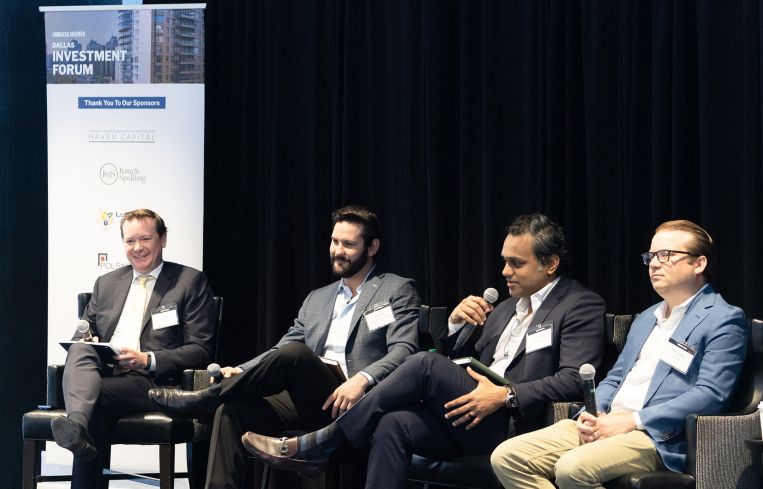Dallas-Fort Worth CRE Investors Eye Macro Trends Warily: Forum
Meanwhile, the conditions on the ground in Texas are pretty favorable to real estate
By Mark Hallum April 18, 2025 3:57 pm
reprints
Investors are going to Texas for more than just an eight-second ride it seems.
Some of the biggest names in Texas real estate — where everything is apparently bigger — shared insights on how the market is faring in their neck of the Great Plains at Commercial Observer’s “Dallas Investment Forum” on April 15.
Three panels discussed the unique opportunities for making money in the Lone Star State while an opening discussion covered affordable housing and lending in a national market full of uncertainties. That opening talk featured Payton Mayes, CEO of homebuilding firm JPI, with CO Associate Editor Gregory Cornfield leading the discussion.
“DFW is our home, where we’re headquartered,” Mayes said, using the local abbreviation for Dallas-Forth Worth. “And I think this market is kind of a prototype for when we’re expanding and how we like to do it, which is what we’re doing now. It’s based on the theory of fewer markets, bigger market share. We’re vertically integrated — we have the land acquisition side, development side and construction. We’re also bringing design in-house. And then, also, we’re integrating some of the trades into our business, which, with our model of being in fewer markets, bigger market share allows us to do that.”
The first panel of the day was “Dallas State of the Market: Exploring Unique Investment Opportunities & Solutions for Increased Cash Flow and Returns,” moderated by Dave Powell of law firm King & Spalding. It featured panelists Jimmy Carrion of investment firm Lloyd Jones, Nadia Christian of Wolverine Interests, Chad Colley of Trademark Property, Ben Curtiss of Kushner Companies, and Vipin Nambiar of HN Capital Partners.
While the policy outlook for Texas real estate is good, the wild headwinds created by the White House can be straight out of a Marty Robbins song.
“We did all the budgets for 2025 — everything looked good,” Carrion said. “And then electricity went up by 25 percent in the last 30 days. For our senior communities, food is the majority of the cost there. We got letters from all the vendors two days ago saying that they’re going to increase prices by 10 percent because of the tariffs. … We just have to readjust when looking at expenses, and you refit your model to the expectations of your investors.”
The next panel, “What’s Being Done to Help the Affordable and Workforce Housing Crisis?” was moderated by Bryan Tony of the Dallas Housing Coalition with panelists Ken Montgomery of Advisor Sphere, Jake Walker of developer The BLVD Group, and Sameer Walvekar of investor Urban Genesis.
The regulatory environment in Texas versus the coastal markets is what is drawing investors for the most part, according to Walvekar.
“Generally speaking, policymakers are understanding — foot forward and development-friendly — so I think the various policy initiatives that are currently making their way through [the legislative process] will be helpful, including reducing parking minimums here in Dallas,” Walvekar said. “Any initiatives that are encouraging density will ultimately lead to more housing.”
Tara Darling of law firm Polsinelli moderated the final panel of the day, “Lending Strategies: Successful Approaches to Securing Funding in a Highly Competitive Market.” The panel featured James Abbee of Goldman Sachs, Jay Porterfield of PGIM Real Estate, Joseph Shanley of Haven Capital, Glenn Silva of C-PACE administrators Lone Star PACE, and John Sloot of lender Greystone.
The interest rate environment is making financing more difficult, to say the least, especially for loans from conventional banks. Nonbank lenders might be the ticket, then, especially for getting clients through special — or tough — times.
“We have bridge financing for your typical value-add deal, a deal on lease-up, but also situations with [U.S. Housing and Urban Development loans],” Sloot said. “A lot of reasons why sponsors don’t want to pursue HUD is because it takes a lot longer. On a refinance or an acquisition, it’s six months to close. So, on an acquisition, that just doesn’t work, a seller isn’t going to wait that long. So we can basically bridge that timing gap, provide a bridge loan so you can close that deal, and then it just rolls into the HUD loan.”
Just call it the Loan Star State.
Mark Hallum can be reached at mhallum@commercialobserver.com.



